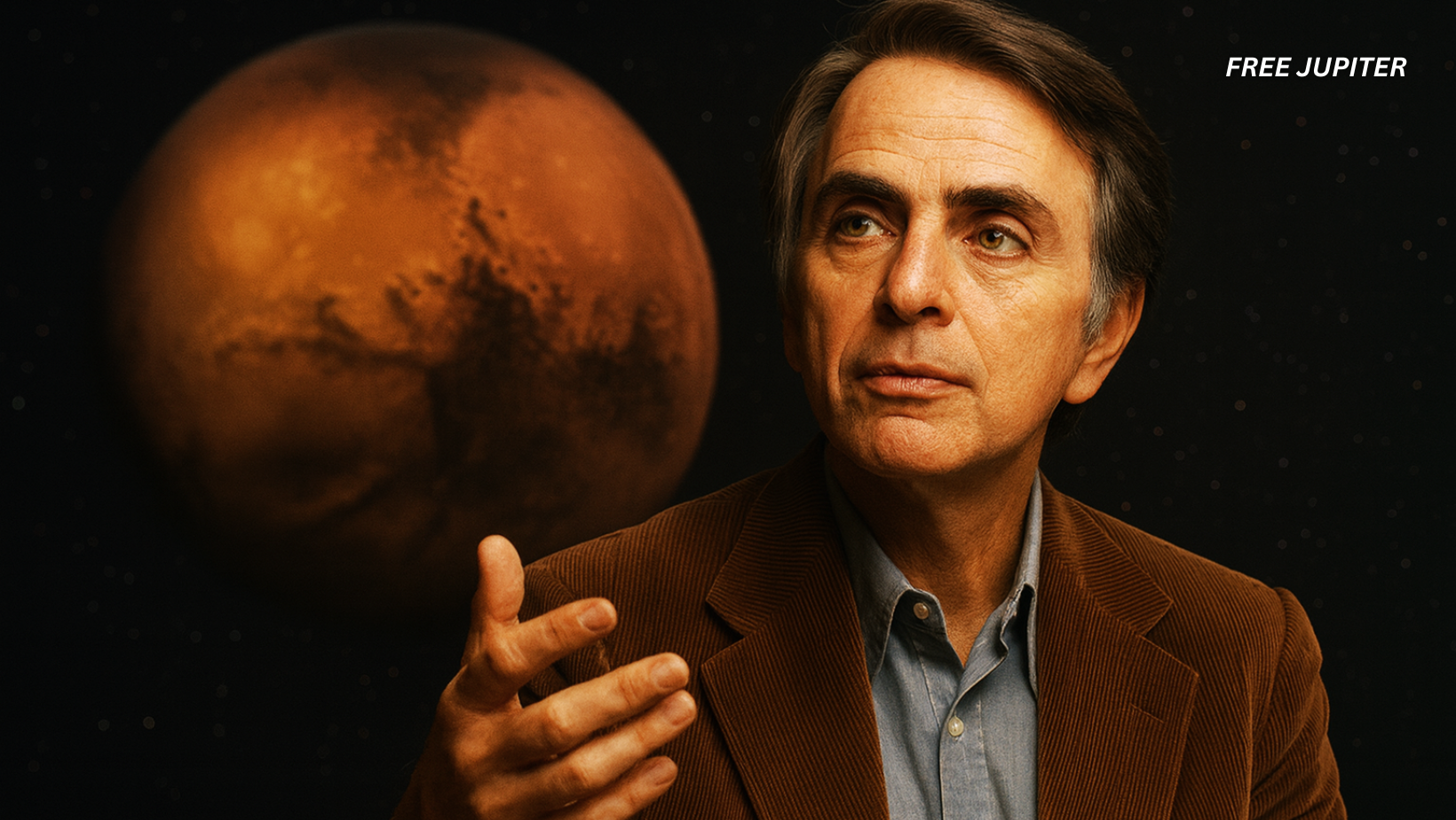Long before anyone planted a boot on Martian soil or snapped a selfie with the dusty red horizon in the background, Carl Sagan quietly recorded a message meant for the very first people who would make that extraordinary journey. It wasn’t for scientists in his own time, nor for students who had grown up watching Cosmos. It was meant for future astronauts — individuals who would eventually walk on a world he dreamed of but never reached.
Sagan, who spent his life turning scientific curiosity into something poetic and deeply human, believed Mars wasn’t simply a place in the sky. To him, it was a destination wrapped in possibility. A mystery. A mirror. A reminder that humanity, at its core, still hungers for exploration.
The message he left behind captures all of that — and more.
The Setting: A Waterfall in Ithaca and a Man Thinking About Another Planet
Near the end of his life in 1996, Sagan sat in a quiet spot in Ithaca, New York, not far from Cornell University where he taught planetary science. Behind him, a tall waterfall thundered against the rocks. You can imagine him smiling slightly as he recorded his message, noting that such a sound would be a rare luxury on Mars, a world far too cold and dry for cascading water.
It’s a simple, almost mundane detail — a waterfall rumbling in the background — yet it makes the moment profoundly human. Here is a man on Earth, surrounded by lush life, talking to future humans living on another world where life, if it ever existed, might have been microscopic and ancient.
It’s the kind of contrast Sagan always loved: the familiar and the cosmic sitting side by side.
Read more: Physicists Have Just Predicted When the Universe Will ‘End’
A Dance Between Fiction and Discovery
In the recording, Sagan describes an ongoing “dance” between scientific discoveries and science fiction. This relationship shaped more than just stories — it shaped careers, missions, and even the modern space industry.
Here’s how Sagan explained it:
- Scientists discover something intriguing about Mars.
- Science fiction writers imagine what that discovery might mean.
- Young readers get inspired by those stories.
- Some of those readers grow up to become scientists.
- Those scientists make new discoveries.
- Writers get inspired again…
- And the cycle continues.
It’s a feedback loop that has existed for more than a century. In fact, Sagan himself was partly shaped by it. Childhood memories of reading adventure-filled, speculative fiction pushed him toward his career in astronomy.
He wasn’t the only one. Early rocketry pioneer Robert Goddard, whom Sagan mentions, once said H.G. Wells’ War of the Worlds stirred his imagination as a teen — eventually leading him to develop the very technologies that made space travel possible.
So in a way, every rover that rolls across Mars owes a tiny debt to the storytellers.
Why Mars? Sagan Gave Several Possibilities
Sagan didn’t want to give future Mars explorers a single explanation. Instead, he offered a handful of possibilities, almost like a buffet of motivations humanity might choose from.
1. Survival Beyond One World
He speculated that humans might travel there as a safeguard — a way to ensure that life continues even if something catastrophic happened on Earth. A planet with no breathable air and blistering cold might seem like an odd backup plan, but in cosmic terms, diversification improves survival.
2. The Scientific Feast Waiting There
Mars is a natural time capsule. Its rust-colored plains and ice-capped poles hold clues about the early solar system and maybe even ancient life. To Sagan, Mars wasn’t just a world — it was a scientific treasure chest waiting to be cracked open.
3. An Ancient Impulse to Roam
Sagan often spoke about humanity’s long history as wanderers. For most of our evolutionary journey, humans lived in constant motion, exploring new landscapes. Maybe reaching Mars is simply the next version of this instinct. New continent, new world, same curiosity.
4. Practical Reasons No One Expected
Toward the end of his message, he even offers a more surprising possibility: maybe humans are on Mars because we learned how to move dangerous asteroids and, once in space doing that job, traveling to Mars became the next logical step. A little planetary defense, a little exploration — all part of the same cosmic neighborhood.
Delivered Across Space: Sagan’s Message Leaves Earth
Sagan never got to see people reach Mars, but he did get to see his message begin its journey.
Thanks to The Planetary Society — the organization he co-founded — the recording was placed aboard NASA’s Phoenix lander. When Phoenix touched down on the Martian arctic on May 25, 2008, Sagan’s voice officially arrived on another world.
The message sits on a durable silica-glass mini-DVD, engineered to last for centuries or possibly millennia. Unless something disturbs the lander, Sagan’s message will remain on Mars long after every living person on Earth has moved on.
In a way, Sagan himself became a tiny part of the Red Planet.
Read more: Why Earth Is the Only Known World In The Universe Where Fire Burns
A Man Who Helped Us See the Cosmos Differently
Sagan’s Mars message becomes even more meaningful when you look at his life’s work. He had an uncanny ability to explain enormous, overwhelming concepts with warmth and clarity.
He taught millions through Cosmos, co-wrote the novel Contact, contributed to NASA missions, and helped design the Golden Record — a time capsule launched aboard the Voyager spacecraft, carrying sounds and images of Earth for any distant civilizations that might find it.
Leaving a note for future Mars explorers feels like a natural extension of everything he valued: curiosity, hope, humility, and connection.
Other “Messages” Humanity Has Sent Into Space
Sagan’s recording isn’t the only symbolic gesture we’ve sent beyond Earth. Here are a few others that echo the same spirit:
The Golden Record (Voyager, 1977)
Sagan played a major role in this interstellar mixtape containing greetings in 55 languages, whale songs, laughter, music, and images of life on Earth. If aliens ever find it, they’ll get a crash course in human culture.
The Mars “Postcards” (Various Missions)
Children around the world have had their names or drawings loaded onto microchips aboard Mars missions, giving them a symbolic presence on other planets.
Messages from Presidents
Some missions included short written messages from world leaders — though none carry quite the poetic charm of Sagan’s.
Aboard the Apollo Missions
Astronauts left plaques, flags, and personal items on the Moon, including a small silicon disc etched with goodwill messages from dozens of nations.
These gestures show something deeply human: even when we explore the unfamiliar, we bring pieces of ourselves along.
Read more: Scientists Explore How ‘Artificial Super Astronauts’ Could Help Humans Colonize Mars
Why Sagan’s Message Still Matters Today
Even though Mars remains uninhabited (for now), Sagan’s words still resonate. They capture something essential about the human spirit — our desire to learn, to wander, and to leave behind messages for the future.
His message also reminds us that space exploration isn’t only about rockets and rovers. It’s about identity. Purpose. Wonder. And the idea that humanity is part of a much bigger story.
When future astronauts finally listen to Sagan’s voice on Martian soil, it will be more than a greeting. It will be a bridge connecting generations of dreamers.
| Related topics: |
| NASA Confirms Mars’ Core Is Solid, Not Molten |
| Huge Chunks of Ancient Space Objects Could Be Buried Inside Mars |
| Multi-Billion-Year-Old ‘Coral’ Found on Mars by NASA |
Featured image: Freepik.
Friendly Note: FreeJupiter.com shares general information for curious minds. Please fact-check all claims and double-check health info with a qualified professional. 🌱










